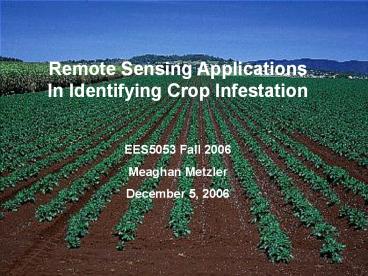Remote%20Sensing%20Applications%20In%20Identifying%20Crop%20Infestation - PowerPoint PPT Presentation
Title:
Remote%20Sensing%20Applications%20In%20Identifying%20Crop%20Infestation
Description:
Cameras with NIR 845-857nm filter, red 625-635nm filter, and ... Data Used cont'. Hyperspectral. Pushbroom camera system. 128 spectral bands 457.2nm-921.7nm ... – PowerPoint PPT presentation
Number of Views:388
Avg rating:3.0/5.0
Title: Remote%20Sensing%20Applications%20In%20Identifying%20Crop%20Infestation
1
Remote Sensing Applications In Identifying Crop
Infestation EES5053 Fall 2006 Meaghan
Metzler December 5, 2006
2
Outline
- Background and Overall Objectives
- Method Description
- Data Used
- Results
- General Conclusions
3
Background
- Remote sensing is the process whereby information
can be obtained from a source without actually
coming in contact with it. - Popular applications include water management,
homeland security, disaster management, and
agriculture efficiency.
4
Agricultural Efficiency
- Crop stress associated with pest infestation is
predominantly monitored through human visual
inspection. - Pest infestation is not normally evenly
distributed within a field. - Pesticide application is expensive and excessive
application can cause resistance in pest species
and damage to the environment
5
Overall Objective
- RS techniques play an important role in timely
detection and early warning of disease and insect
pests El-Khatib et. al. - Damage (or stress) can be identified by changes
in the spectral signature of crop species.
6
Case-In-Point 1 RiceInfested with Sheath Blight
- Location Hazen City, Arkansas
- Field size 762m x 467m
- Infestation naturally infected
- with sheath blight, caused by Rhizoctonia solani
7
Methodology
- Field was divided into 11 strips with 50 sampling
sites for observing the severity of the disease
infestation. - 3 indices used
- SHBDI infected tillers
- SHBDH height (cm) of sheath blight symptoms
- TH height (cm) of plant canopy above soil
- Ground disease index (DI) SHBDI SHBDH / TH
8
Data Used
- Airborne RS images (7/12, 7/24/, 8/04, and 8,17)
- 4 bands 450-540nm, 530-600nm, 610-680nm, and
780-1000nm. - Resolution 1m
- DN 0-255
9
Results
- The change of DI was proportional to that of the
change of DN values however, it was weak. - It was difficult to discriminate from healthy
plants and those with only a light infestation. - Higher spatial resolution and spectral resolution
is required to diagnose crop disease efficiently
and accurately.
10
Case-In-Point 2 Rice Infested with Blast
- Location nursery field at Nattaf
- Research Station, Giza, Egypt
- Field size 70 faddans (one faddan 1.038 acres)
- Infestation infected with bast, caused by
Pyricularia oryzae
11
Methodology
- Reading were taken from a spectroradiometer
- The reading were taken to measure simultaneous
reflected radiance flux in four wavelength of
LANDSAT Multispectral Scanner (MSS) band
0.5-0.6µm, 0.6-0.7µm, 0.7-0.8µm, and 0.8-1.1µm
El-Khatib et. al. - Ratio Vegetation Index (RVI) and Normalized
Difference Vegetation Index (NDVI) were
calculated
12
Results
- The most noticeable changes in the reflection
occurred first in the NIR region. - In the primary stages of blast infestations there
was a decrease in both the green and NIR bands.
13
Case-In-Point 3 Rio Red Grapefruit infested
with Greasy Spot
- Location Texas AM
- University-Kingsville Citrus
- Center in Weslaco, TX
- Field Size about 9.2 acres of grapefruit trees
- Infection Mycosphaerella citri
14
Methodology Data Used
- Airborne multispectral and hyperspectral images
were taken in May 2004 - Multispectral
- Cameras with NIR 845-857nm filter, red 625-635nm
filter, and yellow-green 555nm-565nm filter. - 0.7m spatial resolution
15
Data Used cont.
- Hyperspectral
- Pushbroom camera system
- 128 spectral bands 457.2nm-921.7nm
- Spectral resolution 3.63nm
- Spatial resolution 1.3m
16
Results
- The spatial resolution using the hyperspectral
airborne camera system (1.3m) is rougher, it made
individual trees no longer discernable from one
another - With the increase in bands more detail could be
recorded so there was more classes when
unsupervised classification was done - Hyperspectral system more precisely determines
the health condition of the trees
17
Importance of RS to Agriculture
- Can be used to determine vegetation conditions
more accurately - Saves time
- Saves wear and tear on farming equipment
- Saves money
- Helps limit pesticide use
18
General Conclusions
- By reviewing these experiments the similarities
of each was that because satellite technology
does not have very high spatial resolution needed
that other methods must be implemented such as
airborne multispectral hyperspectral platforms,
or handheld hyperspectral spectroradiometer - From these experiments baseline recordings of
spectral characteristics can be recorded to
validate future recordings from space-borne
platforms.
19
Questions?






























